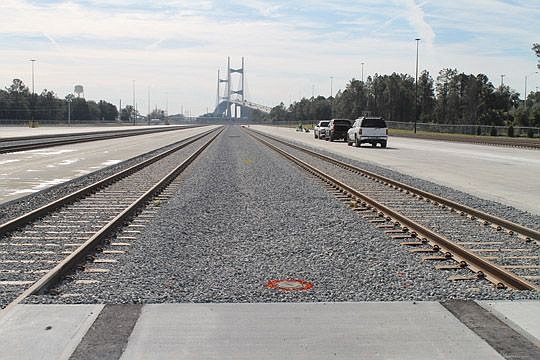
Before he was shipwrecked on a South Pacific island, Tom Hanks in the movie “Cast Away” is a FedEx systems engineer with his hand glued to a stopwatch.
“Every FedEx office has a clock, because we live or we die by the clock,” he says.
At the Port of Jacksonville, the stopwatch measuring container cargo throughput will soon clock a shorter time. In the world of shipping, that’s huge.
A port consultant said JaxPort’s project will save $139.3 million per year in shipping costs.
JaxPort will finish construction this month on its near-dock rail terminal. It means containers moving from the ships to trains will no longer have to be trucked 16 miles to the Westside CSX rail yard. Instead, they can be hauled a few hundred yards from the dock to the new terminal.
It’s an intermodal container transfer facility, or ICTF, and it looks pretty simple. A parking lot big enough to hold 100,000 shipping containers and an incoming CSX rail line that fans out into seven tracks. Four of them are for operations and three for storage.
Better efficiency for shipping customers who are moving containers by a combination of ship and rail? Yes. But it also can help attract more container cargo business to Jacksonville.
Shipping is like a waterfall, port spokeswoman Nancy Rubin said. Cargo will move to the lowest cost location, no matter what.
The extra minutes and money saved by the ICTF can mean the difference between cargo coming through Jacksonville or a different East Coast port.
Industry standards say 25 percent of shipping containers — those that travel the farthest distance over land — benefit from an ICTF.
Construction on the facility will be “substantially complete” this month, said JaxPort Chief Operating Officer Chris Kauffmann.
The $30 million project, which was funded through federal and state grants, will finish on time and under budget.
The port is still finalizing agreements between CSX and Ceres, the facility’s operator. But it expects the ICTF to be operational this year.
It’s the first of four projects to come online that will create a better shipping network.
JaxPort also is working to deepen its shipping channel and to fix dangerous crosscurrents at Mile Point. Plans for a Northside rail corridor are also underway.
Those three projects are higher-dollar than the ICTF and the deepening is considered the most critical to a successful shipping container business.
But the ICTF is a part of the puzzle, too.
“In our view, the ICTF creates an almost seamless transfer of containerized freight from ship to rail,” said CSX spokeswoman Kristin Seay, citing a “significant savings of time and cost.”
The facility will be a “major step forward” in making JaxPort competitive for global commerce and is a “key component for future growth,” she said.
JaxPort CEO Brian Taylor said it will also help Jacksonville to capture container traffic that now goes through other ports.
Today, 8 to 9 percent of JaxPort’s container cargo travels intermodally, meaning from ship to rail. Taylor expects the intermodal share to increase to as high as 20 percent with the ICTF.
Jacksonville is one of the top three ports for shipping containers in Florida, tracking nearly equally with PortMiami and the Port of Everglades at 937,000 containers per year in 2014.
And the expansion of the Panama Canal, slated to finish in a few months, is expected to bring even more containers through East Coast ports.
At JaxPort perhaps no one will benefit more directly than TraPac. The shipping terminal that handles container cargo from Asia can be seen across the highway from the ICTF.
TraPac General Manager Dennis Kelly said he has been “anxiously waiting for it.”
It’s not the only thing he’s been anxiously awaiting.
TraPac’s success depends on Jacksonville getting deep water. It’s a promise that sold the company on opening a container terminal in 2009.
Deep water will allow larger container ships to come to JaxPort, but funding is a hurdle. The $684 million project will be shovel-ready this year.
President Barack Obama’s budget, which came out this week, authorized no new starts for any port project nationwide, including JaxPort’s deepening.
With federal funds scarce, starting construction this year will depend on state and local funding.
The Florida Department of Transportation has put $167 million in its five-year work plan for Jaxport deepening, Taylor said.
The port has also discussed local funding with Mayor Lenny Curry, who has “reiterated his support for the project,” Taylor said. Possible local funding is not expected to come until the city’s next budget cycle, though, which begins July 1.
Kelly considers funding for the deepening critical, now that the Panama Canal expansion is imminent.
“In this industry, it’s all perception,” he said.
If the money comes within the next few months or this year, then Jacksonville is in the race with Savannah and Charleston to capture more cargo, he said.
The ICTF is an important positive, Kelly said. But the real driver will be deep water.
(904) 356-2466